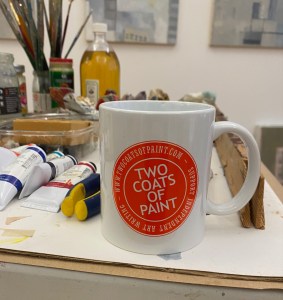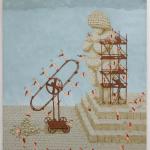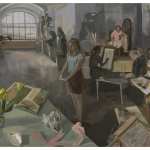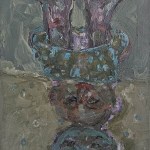
Contributed by Sharon Butler / KK Kozik�s novel ICEHOUSE Project Space, located on the quaint town green in Sharon, Connecticut, is an old 10 x 15-foot wooden shed that was once used to store ice from nearby Mudge Pond. Stephen Maine hung his first site-specific painting there this past November. However rustic, the effort was auspiciously resonant: his painted canvas was wrapped around the interior walls of the shed, completely covering them. Like much of Maine�s work, the painting conjured the all-over pattern of printed fabrics, but as usual he rendered it using a process that involves a handmade contraption that mimics commercial screen-printing techniques without focusing on perfect registration or exactitude.

I stopped by the closing party, where Maine had invited art colleagues, fellow artists, and friends to bring stretcher bars and select sections of the 10 x 45-foot painting that he would cut out, stretch, and let them take home, gratis. I was in the neighborhood having lunch at the nearby White Hart Inn in Salisbury that day, and I didn�t have stretcher bars, but Maine let me choose a piece anyway. I got the lower left corner of the south wall, which he signed and numbered on the back�just in case the pieces are ever brought together in another installation.




ICEHOUSE director KK Kozik told me she knew from the beginning that the space, a two hour drive outside the city, was unlikely to attract a lot of traffic, and that much of the exposure for projects would be virtual. “Viewers would see its site-specific contents via their inboxes rather than in person. To me this gives projects an Andy Goldsworthy-like existence: the projects come together, last for a period of time and then cease to exist except in documentation. Stephen�s project was a perfect manifestation of this concept.�
Called Fire and Ice, Maine’s painting featured a cool, thinly-painted blue background overlaid with bright yellow splotches and organic shapes. Maine wrote in his notes about the show that he �calibrated these two hues to the existing light conditions for maximum optical vibration,� but they also seemed to reference the aquatic plant life and the watery surface of the pond itself.
I brought the painting scrap to my Brooklyn studio, where the canvas sat for several weeks. When I finally stretched it, I recalled the history of Mudge Pond and others like it, where, in the 19th century, before houses had electricity let alone refrigerators and freezers, many New Englanders engaged in a lucrative, if labor-intensive, ice trade. They cut ice from the pond into slabs and shipped them all over the world. Now, as I look at my evocative, newly-stretched 18 x 24-inch painting, the size, shape, and color remind me of a block of ice.
So, more profoundly, does Maine�s post-composition process. Like the icemen in the 1800s, this cleverly expansive artist has sliced up an isolated surface in a small New England town, and generously sent it out into the universe.
“Stephen Maine: Fire and Ice,� produced in cooperation with Brooklyn�s ODETTA Gallery. ICEHOUSE Project Space, Sharon, Connecticut. October 3 through November 6, 2018.
Future projects at ICEHOUSE Project Space: In February Terri Moore will be rendering the inside of an iceberg crevasse, in the spring, look for a drawing installation and an exhibition by Marilla Palmer and Gelah Penn.
Related posts:
Stephen Maine on Gorky�s Grandaughter
IMAGES: Stephen Maine�s BOOK #14-0103














